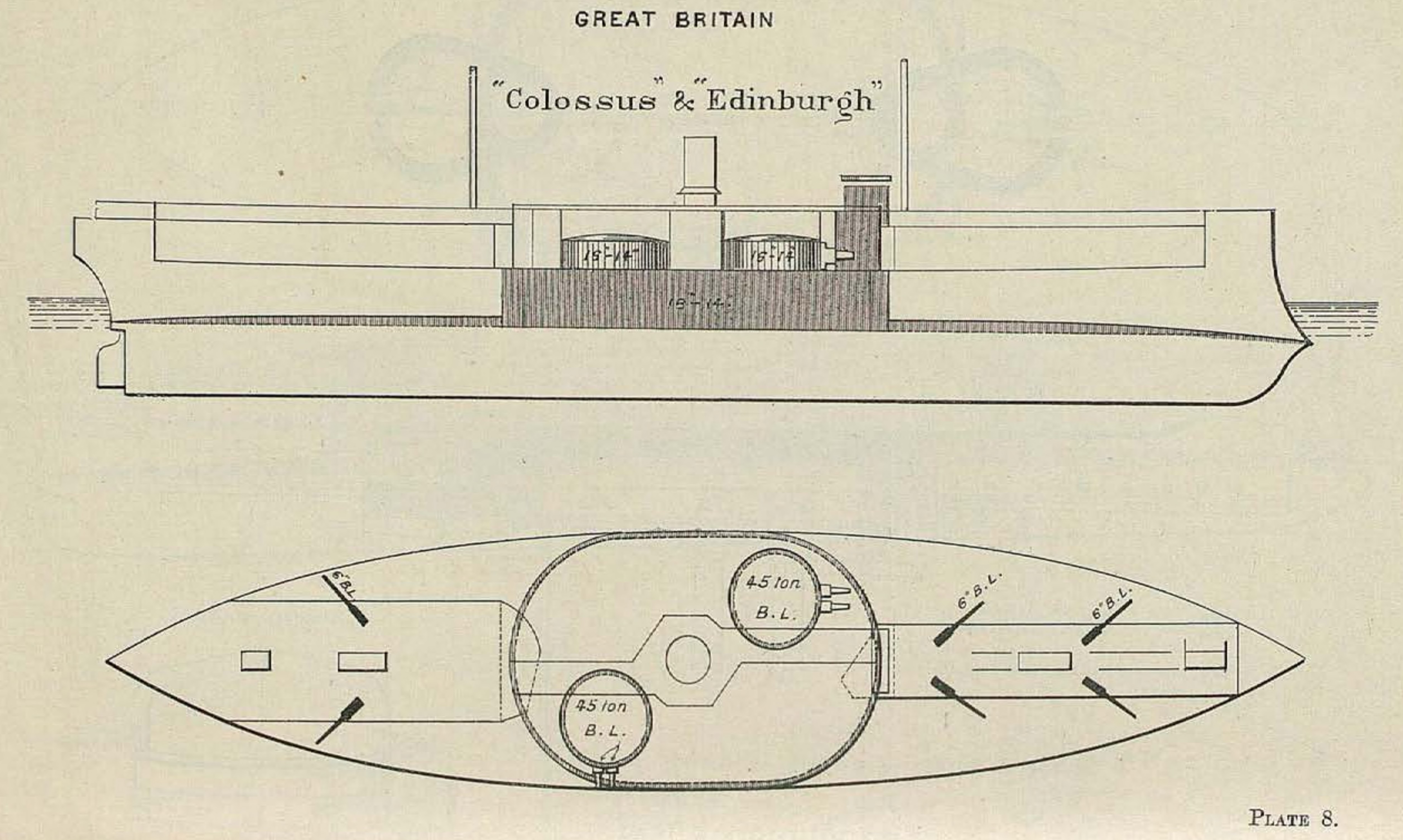Colossus Class Battleship (1882) on:
[Wikipedia]
[Google]
[Amazon]
The ''Colossus''-class battleships were British
 They were in all essential points improved versions of the , with slightly greater displacement, protection and speed, with better handling characteristics, and most significantly, with breech-loading artillery replacing the obsolescent muzzle loaders. They also used steel rather than iron for most of the hull structure, and utilised the innovative compound armour for the belt and turrets.
The class was originally designed to carry the then-standard muzzle-loading artillery, while European navies had already for several years been equipped with breech-loading guns. At this time, for historical reasons, the Board of Admiralty was ultimately responsible for the designs of Royal Naval warships, but the
They were in all essential points improved versions of the , with slightly greater displacement, protection and speed, with better handling characteristics, and most significantly, with breech-loading artillery replacing the obsolescent muzzle loaders. They also used steel rather than iron for most of the hull structure, and utilised the innovative compound armour for the belt and turrets.
The class was originally designed to carry the then-standard muzzle-loading artillery, while European navies had already for several years been equipped with breech-loading guns. At this time, for historical reasons, the Board of Admiralty was ultimately responsible for the designs of Royal Naval warships, but the
An Animated Technical Study of HMS Colossus
{{DEFAULTSORT:Colossus Class Battleship (1882) Battleship classes Victorian-era battleships of the United Kingdom Ship classes of the Royal Navy
ironclad warship
An ironclad is a steam-propelled warship protected by iron or steel armor plates, constructed from 1859 to the early 1890s. The ironclad was developed as a result of the vulnerability of wooden warships to explosive or incendiary shells. Th ...
s, carrying their main armament in turrets, which served in the Victorian Royal Navy
The Royal Navy (RN) is the United Kingdom's naval warfare force. Although warships were used by English and Scottish kings from the early medieval period, the first major maritime engagements were fought in the Hundred Years' War against ...
from 1882. They were the first British warships to carry large rifled breech-loading main guns.
Design
 They were in all essential points improved versions of the , with slightly greater displacement, protection and speed, with better handling characteristics, and most significantly, with breech-loading artillery replacing the obsolescent muzzle loaders. They also used steel rather than iron for most of the hull structure, and utilised the innovative compound armour for the belt and turrets.
The class was originally designed to carry the then-standard muzzle-loading artillery, while European navies had already for several years been equipped with breech-loading guns. At this time, for historical reasons, the Board of Admiralty was ultimately responsible for the designs of Royal Naval warships, but the
They were in all essential points improved versions of the , with slightly greater displacement, protection and speed, with better handling characteristics, and most significantly, with breech-loading artillery replacing the obsolescent muzzle loaders. They also used steel rather than iron for most of the hull structure, and utilised the innovative compound armour for the belt and turrets.
The class was originally designed to carry the then-standard muzzle-loading artillery, while European navies had already for several years been equipped with breech-loading guns. At this time, for historical reasons, the Board of Admiralty was ultimately responsible for the designs of Royal Naval warships, but the War Office
The War Office was a department of the British Government responsible for the administration of the British Army between 1857 and 1964, when its functions were transferred to the new Ministry of Defence (MoD). This article contains text from ...
was responsible for the design and provision of naval artillery. In 1879, while the ''Colossus'' class was under construction, a 100-ton muzzle-loader was being tested at the Royal Arsenal, Woolwich
Woolwich () is a district in southeast London, England, within the Royal Borough of Greenwich.
The district's location on the River Thames led to its status as an important naval, military and industrial area; a role that was maintained thr ...
, and the 16-inch 80-ton guns destined for were nearly complete. Responding to a groundswell of professional opinion, the Admiralty sent a group of senior officers to witness and report on the performance of the new breech-loading weapons being produced by Krupp in Essen. As a result of their report, Woolwich undertook the manufacture of 12 inch calibre breech-loaders, with a breech mechanism manufactured at Elswick. The ''Colossus'' class was nominated to be armed with these guns; the delay in their manufacture largely accounts for the protracted building times of these vessels.
Both ships did well on sea-trials, exceeding their design speed. They threw up what is described as a "remarkable bow wave, which rose like a solid wall for thirteen feet, the like of which has never been observed." They had a quick roll, and because of the low freeboard and the long chases of the guns, the gun muzzles dipped into the sea at a roll of 13° when trained on the beam. They were fitted with large bilge keels and with anti-rolling tanks.
They were both reported to be slow to respond to the helm, with large turning circles.
Ships
References
* *External links
An Animated Technical Study of HMS Colossus
{{DEFAULTSORT:Colossus Class Battleship (1882) Battleship classes Victorian-era battleships of the United Kingdom Ship classes of the Royal Navy